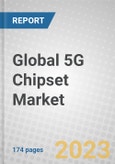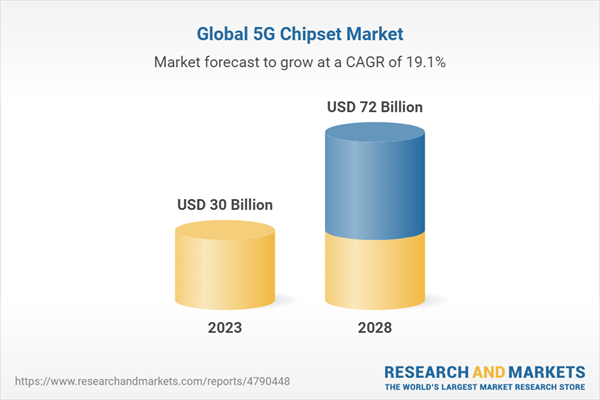In this report, the 5G chipset market was segmented by component, industry and geography. The report provides an overview of the global 5G chipset market and analyzes market trends. Using 2022 as the base year, the report provides estimated market data for the forecast period 2023 through 2028.
Revenue forecasts for this period are segmented into:
- Deployment type: network infrastructure, smart gadgets, smartphones, routers/modems and others.
- Wafer material type: GaN (gallium nitride)-based chipsets, GaAs (gallium arsenide)-based chipsets, InP (indium phosphide)-based chipsets, SiN (silicon nitride)-based chipsets, Si-based chipsets and others.
- IC type: RFIC, ASIC, cellular IC and mmWave IC.
- End use: telecom infrastructure, automotive, building automation, industrial automation, retail, Energy and utilities, consumer electronics and others.
- Region: North America is segmented into the U.S., Canada and Mexico; Europe is segmented into the U.K., France, Germany and Rest of Europe; the UK is further segmented into England, Wales, Scotland and Northern Ireland; Asia-Pacific (APAC) is segmented into China, Japan, India and the Rest of Asia-Pacific; Rest of the World is segmented into Middle East, Africa and Latin America.
COVID-19 had a massive impact on society beginning in 2020. This report considers the impact of COVID-19 and the economic slowdown it created. With people relying more on technology, the demand for 5G chipset will increase and boost market growth. The report also focuses on the main trends and challenges that affect the market and the vendor landscape.
This report has been prepared in a simple easy-to-understand format, with a number of tables and charts/figures. The scope of the report includes a detailed study of global and regional markets for 5G chipset, with reasons given for variations in the growth of the industry in certain regions. The report examines each component of 5G chipset technology, determines its current market size and estimates its future market. The report also analyzes the market from the manufacturers’ viewpoint, as well as that of the final consumer. A number of technical issues arising out of the use of 5G chipset technologies are discussed and solutions are indicated.
Report Includes
- 46 data tables and 20 additional tables
- An overview and up-to-date analysis of the global markets for the 5G chipset technologies
- Analyses of the global market trends, with historic market revenue data (sales figures) for 2022, estimates for 2023, forecasts for 2024, and projections of compound annual growth rates (CAGRs) through 2028
- Discussion of the major growth drivers, industry-specific challenges, technology updates, and government policies and regulations for manufacturing of 5G semiconductor chipsets, that will shape the market as a basis for projecting demand in the next few years (2023-2028)
- Estimation of the actual market size and revenue forecast for the global 5G chipset market, and corresponding market share analysis based on the type of deployment type, wafer material, integrated circuit (IC) type, end use, and region
- Identification of viable technology drivers through a holistic review of various platform technologies, major types of end user markets, and adoption of 5G chipsets across a broad spectrum of industry verticals
- Review of the major industry trends, upcoming technologies and emerging new developments in the global 5G chipset industry
- A relevant patent analysis on the global supply chain management technologies, applications and solutions and review of recent key granted patents
- Insight into the recent industry structure, competitive aspects of each product segment, increasing investment on R&D activities, market development strategies, and company value share analysis
- Identification of the major stakeholders and analysis of the competitive landscape based on recent developments and segmental revenues
- Company profiles of major players within the industry, including Broadcom Inc., Huawei Technologies Co. Ltd., Intel Corp., Qualcomm Technologies Inc., and Samsung Electronics Co. Ltd.
Table of Contents
Executive Summary
The next generation of technology demands improved data speed. The demand for connectivity is expected to be driven by trends like autonomous cars, smart cities, industrial automation and IoT (Internet of Things). The ever-increasing demand for broad network coverage and high-speed internet, with reduced power consumption and latency, will augment the growth of the global 5G chipset market during the projection period. With 5G networks to be rolled out soon, the network providers and the original equipment manufacturers (OEMs) of smartphones are gearing up for the transition phase. 5G networks rely on the cloud and arrays of small antenna to provide ultra-speed data for mobile communication. The network band is different than that of the 4G (LTE) band, so smartphone OEMs are looking to equip handsets with 5G-enabled modem chipsets for end-to-end communication. The major manufacturers of 5G chipsets for handsets are Qualcomm, Samsung, Intel, MediaTek and Huawei. In terms of industry, the telecom and consumer electronics segment is expected to see significant growth in the 5G chipset market, driven by the need for real-time data processing and analysis in remote patient monitoring and telemedicine. The manufacturing industry is also expected to be a major contributor to the growth of the 5G chipset market, as companies look for ways to improve supply chain management and manufacturing processes. The Energy and Utilities segment is expected to be the fastest growing segment throughout the forecast period.
In terms of geographic regions, Asia-Pacific held the highest revenue share in the market in 2022 at $17.4 billion and it is expected that it will continue to dominate with a value of $48.5 billion in 2028. The Asia-Pacific region has many companies supplying 5G chipsets. In this region, Japan, Korea and China are the key countries where demand is being generated and most players are located in APAC.
However, the North American region held the second largest share of the global market and is expected to offer substantial market potential for the 5G chipset market, expanding at a CAGR of 20.7% during the forecast period, expected to reach $15.5 billion in 2028, up from $5.2 billion in 2022. Since North America is a quick adopter of technological advancements, the 5G chipset market swiftly formed a strong base in the region. High demand for advanced technologies like artificial intelligence, machine-tomachine communication and connected cars will provide huge opportunities for the development of the 5G chipset market in North America.
Overall, the 5G chipset market is experiencing strong growth and is expected to continue to expand rapidly in the coming years as more businesses adopt 5G chipsets to improve data processing capabilities.
Companies Mentioned
- Advanced Micro Devices Inc.
- Analog Devices Inc.
- Broadcom Inc.
- Hewlett Packard Enterprise Co.
- Huawei Technologies Co. Ltd.
- Infineon Technologies AG
- Intel Corp.
- Mediatek Inc.
- Nokia Corp.
- Nxp Semiconductors N.V.
- Qorvo Inc.
- Qualcomm Technologies Inc.
- Renesas Electronics Corp.
- Samsung Electronics Co. Ltd.
- Stmicroelectronics N.V.
- Texas Instruments Inc.
- Telefonaktiebolaget Lm Ericsson (Ericsson)
- U-Blox Holding AG
- Zte Corp.
Table Information
| Report Attribute | Details |
|---|---|
| No. of Pages | 174 |
| Published | June 2023 |
| Forecast Period | 2023 - 2028 |
| Estimated Market Value ( USD | $ 30 Billion |
| Forecasted Market Value ( USD | $ 72 Billion |
| Compound Annual Growth Rate | 19.1% |
| Regions Covered | Global |
| No. of Companies Mentioned | 19 |









